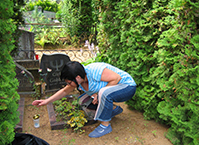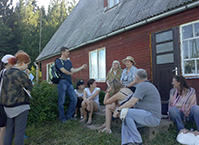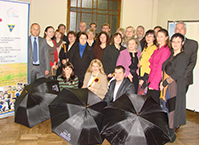About the plants
Categories: Liga Seikste-Deksne
Plants at home, decorative and other plants around the farmstead in a historical aspect. What can you tell about it?
Already in my childhood, my parents’ home had a name “Lindens”, and thus there grew some four huge lindens around the house. As to the decorative plants, of course, those were lilac, jasmine. What concerns flowers, there were snowdrops, which grew wild, peonies – white, pink and dark red, and there were asters in autumn. Those, probably, were the most traditional flowers, which grew at every house. Of course, people planted a huge rhubarb as a decorative plant on a rather beautifully mowed lawn in the yard, in some place there was a huge bush of Jerusalem artichoke, which usually was planted in front of a woodshed or some other less aesthetically looking building. Shadberries, rowan trees – but in principle, those tree plants were for practical use, i.e. they were grown more like fruit trees – either those berry bushes or apple trees.
Although, in my childhood, my godfather was one of those men, who earned their seed capital by carrying tulips to sell in Leningrad, and thus they were growing tulip bulbs. When he visited us, he gave some tulip bulbs to my mom, but tulips were considered very chic flowers that one could boast of in front of his neighbours, since the choice of various sorts was very limited. In very few gardens there were lilies, which were dug out in different ways, because they were not frost hardy, there were not so many varieties as nowadays. That was a very rare case. When I was about 15 years old, then dahlias appeared as a rare deficit, but already then, those dahlias were of very different colours and of very different forms. They could be rather well preserved. I know that my mother exchanged dahlia plants with some of the enthusiastic neighbours. They brought them to each other in huge potato boxes. Dahlias were planted to form sort of lanes along the driveways, and there were many people who spent much time over them. I even know the neighbours, who said that it was not a decorative plant; they said it was rather a silage plant. I know that in autumn, after the first frosts, dahlias were cut and ensilaged in big barrels to feed the cattle.
And what grew inside the house?
Inside the house, there was an aspidistra almost in all the homes. In many homes, in the southern part of the house people grew fuchsias on the windowsills. Aloes, kalanchoes – those were meant more for health care. At the same time, to say that there were many houseplants, well, there was a lot in very rare houses and then that was mainly in the village centres, where people had large windows, because many, so to say, old country houses, they simply had comparatively small windows. For winter, people put double window glasses, and those windows barely performed their room lighting function. No room houseplant would grow well on such a windowsill. Therefore, I can’t say that people were eager to grow plants at home – those were mostly aloes, kalanchoes, maybe some health bulb – i.e. those plants which are used either for wound treatment, or consumption or medication.
Audio
Researcher: Dr. philol. Valentīns Lukaševičs, Daugavpils Universitāte










